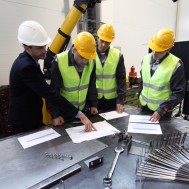As devastating as they are, natural disasters are inevitable. But that doesn’t mean they should keep you and your business from achieving successful outcomes. In fact, natural disasters should serve as calls to achieve one of the most important outcomes: continuity.
That’s why recovery planning is especially applicable to the manufacturing industry. We have to plan more than one step ahead every step of the way. However, given the unpredictability of natural disasters, recovery planning isn’t easy.
It’s worth it, though, as a comprehensive plan will provide you and your business with the opportunity to properly gauge your place in the market. But how exactly is that process started? We’re here to help you figure that out.
Backup important documents and contacts.
It shouldn’t take a natural disaster to come to terms with the importance of backing up data. But when disaster strikes, that importance becomes abundantly clear. And whether it’s tangible or digital, one thing is for sure: data is what your business runs on. Still, it’s easy to forget that.
Backup processes allow you and your business to run more efficiently. The action of backing up will give you peace of mind, too. In that way, we recommend not being one of the 20 to 35 percent of business owners who leave their data unprotected, and subsequently, their entire business operations system at risk.
So what should you do? Make sure your files related to the function of your business (including insurance policies and other financial documents) are copied and backed up onto external hard drives. Additionally, do the same for information related to your clients and business partners. This is about safeguarding you and your business’ ability to produce in even the hardest of situations. The time you spend on maintaining your digital inventory is money saved on sustaining your entire business.
Identify specific threats to your business.
Often, the world around you and your business is taken for granted. You’re not typically concerned about the weather, nor are you worried about the actual infrastructure of your building. But you should be, especially if the area you live in is prone to natural disasters.
Threats span far outside of supplier concerns, federal, state and local regulations and even general business competition. Damages caused by natural occurrences can threaten your business for years if not properly prepared for. That’s why natural disasters were listed among the top 12 risk factors for manufacturers in 2016. And why the environment your business takes place in should be regularly monitored and kept in mind.
But how does this process begin? To start, you need to make sure the building your business operations take place in is up to code. Additionally, you must stay up to date with environmental factors on a day-to-day basis. You should even plan ahead by gauging the possibility of natural disasters monthly. It’s a lot of work, but again, we assure you it’s worth your time.
Develop an efficient communication method.
When disaster strikes, it’s important to stay calm. And while most natural disasters seem to happen in a blink of an eye, efficient communication takes long-term training and dedication. That makes strategic communication vital in moments of uncertainty. It comes down to calculated management.
Being able to effectively communicate in times of both ease and hardship are two integral traits in a successful leader. So when you’re thinking about this aspect of your business’ recovery planning, you must think about, among various other factors, the flow of managerial power, potential implementation of streamlined communication devices and even client relationships.
The development of an efficient communication method should be applicable to any situation you and your business could potentially encounter. Your clients expect comprehensiveness. Your competition is already practicing their sense of cohesiveness. And even though it’s a time consuming process, you’ll ultimately feel much better safe than sorry.
Review, test and update your plan.
Generalized plans aside, it’s extremely important to create a specific plan regarding your course of action if a natural disaster ever does touch land. In fact, the longevity of your business depends on it. But this step will be especially different for every manufacturing leader. For just as no two natural disasters interact with the environment the same way, no two business leaders interact with their business the same way.
So, it makes sense that this step is about individualization. But it’s primarily rooted in your relationship with local authorities, other business leaders and the people who help make up your business. That said, it helps to look at empirical data associated with disaster recovery plans and strategies. Once you locate a plan template that works for you, it’s time to test it out with your business.
If you encounter any problems, feel confident in your ability to come to terms with your short comings as well as your ability to overcome them. It’ll be a humbling experience, but successfully growing from it will positively affect your entire business processes. Update your plan consistently, while continuously striving for the most effective means of recovery. Not only will it help you in times of disaster, but it’ll improve your ability to sustain business operations on a day to day basis.
How does your manufacturing plant plan for natural disasters?
Do you have a manufacturing recover plan in place for natural disasters? We’d like to hear about it. Let us know by tweeting us at @AppleRubber.
